A BILSTON FAMILY IN THE 20TH CENTURY
|
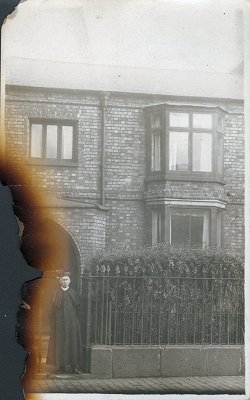 |
I am afraid this photo got burnt in one corner but the flames have, of course, spared Father Sprague, who is standing outside the Presbytery of Holy Trinity Church. It stood where the car park and the flagpole now are. | 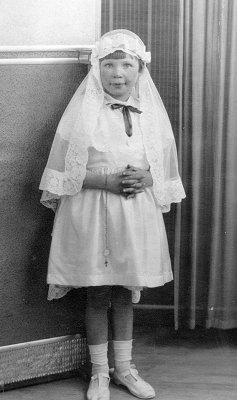 |
This is me, aged seven, at my first communion, 1936. |
| This hand tinted photo is my infant's school Crowning of Our Lady procession. At the back: Joan Pope and Sheila Jordan (now Fawcett); in the middle: me; at the front: Monica Walton (who married a Dutchman) and Margaret Elsden. (Margaret later became the church organist and I became the church choir mistress). | 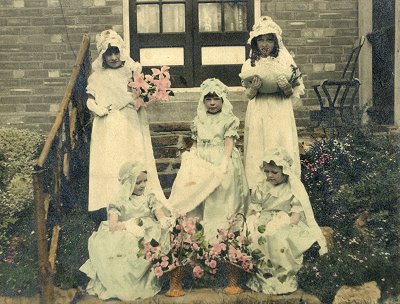 |
Father Sprague with the altar servers. Left to right: Ernest Elsden, Ray Fletcher, Father Sprague, Bernard Shaw, Val Kiely (who later became my husband) and in front of him: Joseph Taylor (my brother). |
 |
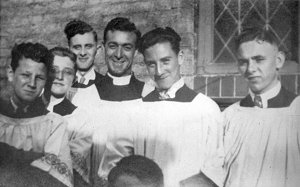 |
Father Michael McGrath with the altar servers. Left to right: Colin Fletcher, Ernie Elsden, Val Kiely, Father McGrath, Ray Fletcher, Bernard Shaw. |
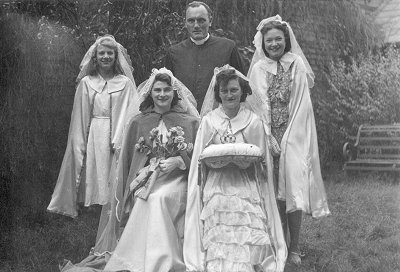 |
This photo was taken at the October Procession in about 1945, when the Children of Mary crowned the statue of Our Lady. With Father Timothy Connolly are, left to right: Frances Taylor (my sister), Barabara Horton, Sylvia Smith, Hilda Stanley. The photo was taken in the infants' school playground. |
| The same occasion a year later, about 1946. left to right: Christine Myatt, Edna Bold, Kathleen Taylor (me!), Kitty Rowley. |
 |
The Trinity Players were an amateur theatrical group which was based at the church. This photo shows Frances and Joseph Taylor in "When we are Married". They also did "Tons of Money". They performed in the British Restaurant at Bilston. |
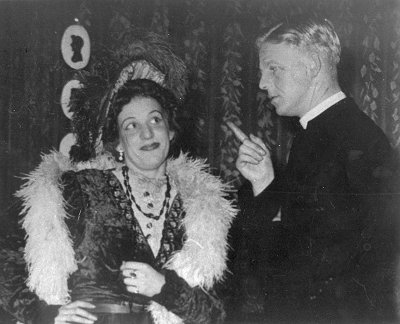 |
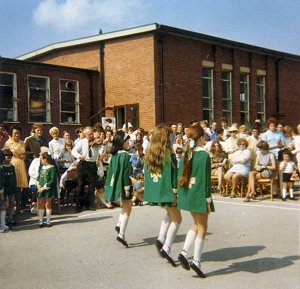 |
This is from later on. It is a snap taken at the Summer Fete held in the school grounds. These are some Irish dancers. But there were all the usual things like rides, cocoanut shy, bric-a-brac stalls, and so on. One highlight was always strawberries and cream; the men used to go out a pick the strawberries at a local farm on the morning of the fete and we served them with ice cream. The Boys Scouts ran a hot dog stall. |
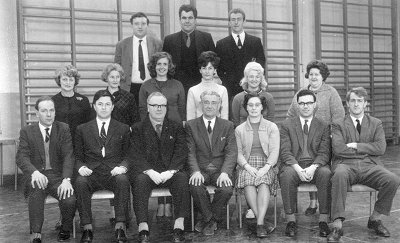 |
The church organised trips. This photo was taken in the Holy Land. My mother is in the middle of the front row, wearing a white hat. Our church's senior school was the Thomas More School at Willenhall. This is photograph is of the school staff. In the centre of the front row id the Head Master, Mr. Billings. My sister Mary is in the middle row, two from the right. |
| The church organised trips. This photo was taken in the Holy Land. My mother is in the middle of the front row, wearing a white hat. |
 |
Our church's senior school was the Thomas More School at Willenhall. This is photograph is of the school staff. In the centre of the front row id the Head Master, Mr. Billings. My sister Mary is in the middle row, two from the right. |  |
Joan McTighe has lent me an old newspaper clipping about Father Sprague. It calls him the Rev. "Sherlock Holmes" of Bilston and also, for good measure, says that, like Chesterton's Father Brown, he is a Roman Catholic priest who "is a very successful amateur detective and has been instrumental in bringing a number of clever criminals to book". Farther Sprague told the reporter that "it is not merely my gift for keen observation which enables me to help the police as I have done but it is also a considerable knowledge of men which I got before I was a parson when I worked among them as an engineer". He tells several stories of how he recognised people as fruadsters. "When these chaps see a minister they say to themselves 'Here's a damn fool. I'll rook him'. They think a fool and his money are soon parted". And he tells stories such as that of the man dressed as a naval officer who told Father Sprague he had lost his money and needed his fare back to Liverpool. The Father was generous but suspicious and quickly noted every feature of the man and even an address on a letter the man had with him. So when no repayment of the loan was forthcoming the police had a good description and an important lead; the man, who was not a naval officer at all and had played this trick elsewhere, was duly arrested in Liverpool. But on another occasion a man approached Father Sprague for money, saying he had come from Wolverhampton for work and had had nothing to eat or drink for two days. But Father Sprague remembered that earlier he had been passing the Angel Inn and had seen this very man coming out of it. So he said to him "I'll give you a bob for being the biggest liar I ever met" and threw a shilling at him. "Thanks" said the man, quite unperturbed, catching the shilling and walking away.
Joan McTighe has also leant me a newspaper clipping from 27th May 1928, when the Crowning of the Madonna took place on Whit Sunday. The newspaper says that this custom was a very old one "which has been revived of late in certain districts". According to the report the procession formed up in the aisle of Holy Trinity church and moved out into the street. "Following office bearers came 42 children from the infants' school, dressed in white. The youngest in the procession was four years old and there was not one over seven. The little girls were attired in white with net veils and silver leaf ornaments on their hair. They carried bouquets of blue iris and white broom and the boys, also in white, carried Madonna lilies. The May Queen was Moira Corrigan, a little lady of five, and the bearers of her elaborate train were Joan McTighe and Irene Parker. The crown was carried by James O'Shaughnessy". There was a "short procession" before they returned to the church. As you can see, in my time all the participants were older girls.